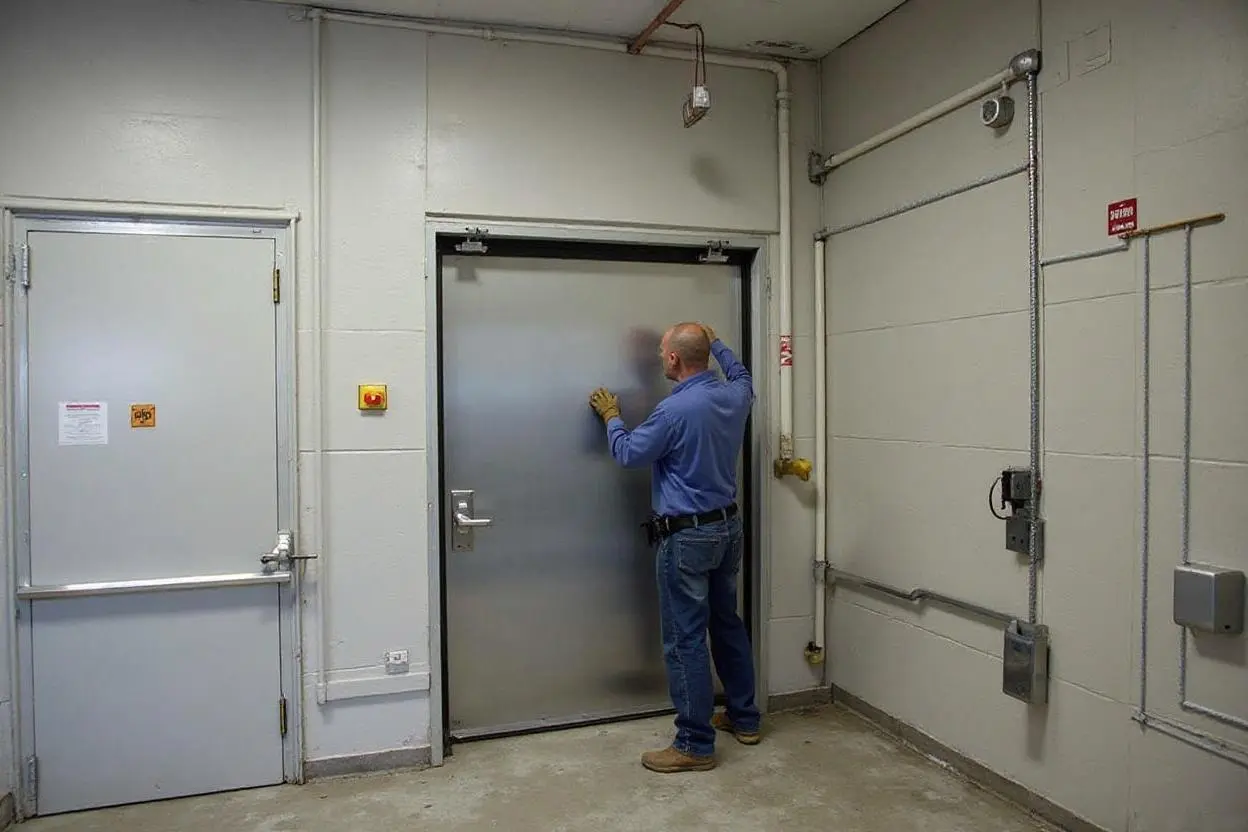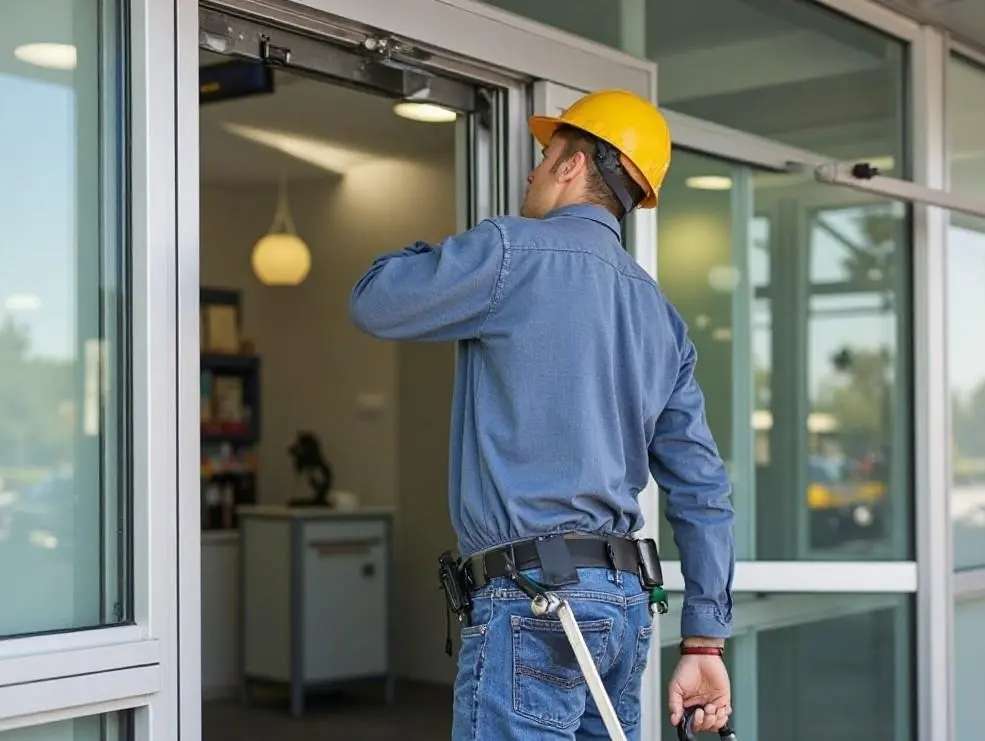How to Fix an Automatic Sliding Door: DIY Troubleshooting
Automatic sliding doors make life easier until they stutter, drag, or stop moving altogether. In Buffalo, door issues often trace back to weather, salt, and heavy use in busy entryways. This guide walks through safe DIY checks that solve many common problems. It also clarifies where a professional is required. Readers who need fast automatic sliding doors repair in Buffalo can schedule service with A-24 Hour Door National Inc for same-day help across downtown, Elmwood Village, North Buffalo, Cheektowaga, and Amherst.
Safety first, then diagnosis
Automatic doors move weight and glass with torque that can injure someone who stands in the wrong spot. Power down before touching mechanics. Keep people clear of the path. If the door serves a public entrance, put up a temporary sign and direct foot traffic to a manual door.
Buffalo buildings see freeze-thaw cycles that loosen fasteners and warp tracks. Salt and grit from sidewalks migrate into rollers and sensors. Many “mystery” failures come down to dirt, corrosion, or a simple setting that drifted.
Quick checks that solve half of callbacks
Start with what takes seconds. These items resolve a large share of service calls, especially after a storm or a busy weekend.
- Confirm power and mode: Verify the breaker is on and the header’s control switch is set to “Auto,” not “Hold Open” or “Exit Only.”
- Clear the threshold: Remove pebbles, rock salt, and ice from the track and floor guide. Even a bottle cap can stop a panel.
- Clean sensors: Wipe the presence and activation sensors with a soft cloth. Dust, salt film, or spider webs block beams.
- Test motion range: Open and close the door manually with the power off. It should slide smoothly without sticking.
- Check for obstructions at the header: Loose ceiling tiles or seasonal décor can block the sensor field.
If the door returns to normal after these steps, keep a weekly cleaning routine through Buffalo’s winter to prevent repeat issues.
Understanding the components you may touch
On most automatic sliders, the moving parts sit inside the header above the opening. The motor pulls a belt attached to hangers that carry the door panel. Floor guides keep the panel from swinging. Activation sensors (overhead radar or motion) tell the door to open. Presence sensors keep it from closing on a person or cart. Side safety beams watch the pinch area.
A property manager can clean, tighten exterior fasteners, and verify settings from a user control panel if present. Leave motor, belt tension, and controller parameters to a technician to avoid misalignment or code violations.
Common Buffalo-specific symptoms and fixes
Door opens, then immediately closes too fast. This often appears on windy days along Niagara Street or near the waterfront. Strong crosswinds trick presence sensors. Adjust sensitivity on the user panel if available, and make sure floor mats are not curling into the sensor zone. Check the closing speed knob only if it is labeled for user adjustment. If the door slams, call for service to reset close force within ANSI A156.10 limits.
Door hesitates or shudders on first move in the morning. Overnight freezing can stiffen rollers and thicken grease. Warm the A-24 Hour Door National Inc: automatic sliding doors repair Buffalo header space by running the HVAC fan mode for 15 minutes. Clean the bottom track and apply a plastic-safe dry silicone to the guide only, not to the overhead track. Oily sprays collect grit and make it worse next week.

Door stays open in heavy snow. Packed snow in the track or a blocked safety beam keeps the controller in “safe open.” Clear slush from the threshold and wipe the beam lenses at knee height. If the beam LED shows fault after cleaning, call for repair; the emitter or receiver may have moisture intrusion.
Door does not respond, but lights are on. The control is likely in “Hold Open,” common after deliveries. Check the keyed selector or push button near the header. If set to Auto and still no response, test each activation device. Wave a hand under the sensor and watch for an indicator light. If all sensors seem dead, the controller may be in fault after a power dip from a storm. Power cycle the breaker for one minute. If it recovers, log the event; repeated drops suggest a failing power supply.
Door squeaks or scrapes along the bottom. Debris sits under the floor guide or the bottom of the stile is rubbing due to sagging hangers. Clean the guide slot. If scraping continues, stop and schedule service. Continued operation can chip the glass edge.
Simple cleaning that prevents breakdowns
Regular cleaning saves money, especially through Buffalo winters. Use a soft cloth and a mild glass cleaner for the door lite and sensor windows. For tracks and guides, vacuum loose debris, then wipe with a damp cloth. Avoid pouring water into the header or track in freezing weather. Skip grease on tracks and rollers; factory components are pre-lubricated, and added oil attracts grit.
A monthly five-minute check helps: verify screws on sensor housings are snug, weatherstrips are intact, and mats do not creep into sensor zones. Write down any new noises so a technician can diagnose faster.
Settings you can verify without tools
Many systems provide user-level dials or menus on the header cover. Common, safe checks include operating mode, hold-open time, and sensor sensitivity if labels explicitly mention “user.” Small changes often resolve nuisance issues. Keep changes within the marked range and note original positions before adjusting.
Avoid changing learn cycles, door weight, motor current, or DIP switch arrays. These affect safety compliance and can create liability if set outside standard. In New York, commercial automatic sliding doors must meet ANSI A156.10. A-24 Hour Door National Inc handles compliance testing, signage, and safety checks after any adjustment.
When to stop and call a pro
Two cases mean stop DIY immediately: glass alignment that changes suddenly after a bump, and any cable or belt that looks frayed. Another red flag is a door that fails a “presence test” — place an empty cart or box in the threshold, and the door still tries to close. If that happens, keep the door on Hold Open and request urgent service.

Other times it pays to call: intermittent faults after rain, header water leaks, or loud grinding from the motor area. Those point to worn rollers, failing gearboxes, ingress in the controller, or sensor wiring issues. Working in the header without training risks injury and longer downtime.
What a technician does that DIY cannot
A trained technician measures close force with a gauge, resets controller parameters, and aligns sensors to ANSI standards. On site, they inspect roller wear, belt tension, hanger bolts, and end stops. In Buffalo, they also look for salt corrosion on lower hardware and condensation pathing inside older headers. In many cases, a 45-minute visit restores smooth motion and extends service life by a year or more.
A-24 Hour Door National Inc carries parts for common brands found around Buffalo and the suburbs. That includes operators seen in medical offices along Delaware Avenue, grocery entries in West Seneca, and university buildings near North Campus. Most minor repairs finish the same day.
DIY step-by-step: safe essentials only
Use this short process for a basic reset after a jam or sensor issue.
- Power down at the breaker and set the selector to Off. Post a sign and keep the doorway clear.
- Clean the track, floor guide, and sensor lenses. Remove slush, salt, and debris.
- Move the door panel by hand. It should glide without binding. If it binds, stop and call.
- Restore power, set to Auto, and test open-close three times. Watch sensors; the door must not close on an object.
- If performance improves, monitor for two days. If symptoms return, schedule service to correct the root cause.
Costs, timelines, and weather realities in Buffalo
Most sensor cleanings and user-level resets cost nothing but time. Professional service for minor issues like roller adjustments or sensor recalibration often lands in the low hundreds, depending on parts. Emergency winter calls may add a trip fee, yet they save a busy storefront from lost foot traffic. Lead times during storms can stretch a few hours, but same-day coverage is common across Buffalo, Tonawanda, and Orchard Park.
Consider a twice-yearly maintenance visit: one in October before the first freeze, and one in April after thaw. That cadence pays off in reduced downtime and better safety compliance.
Ready help for automatic sliding doors repair in Buffalo
If the door still acts up after the checks above, it needs professional hands. A-24 Hour Door National Inc provides automatic sliding doors repair in Buffalo with fast response, clean workmanship, and code-compliant testing. The team services retail, healthcare, and multi-tenant buildings across downtown Buffalo, Kenmore, South Buffalo, and the Northtowns.
Call to schedule a repair or book a preventative tune-up. Share the symptoms, brand, and any error lights, and mention what you already tried. That detail speeds the fix and gets the entrance moving smoothly again.
A-24 Hour Door National Inc provides commercial and residential door repair in Buffalo, NY. Our technicians service and replace a wide range of entry systems, including automatic business doors, hollow metal frames, storefront entrances, fire-rated steel and wood doors, and both sectional and rolling steel garage doors. We’re available 24/7, including holidays, to deliver emergency repairs and keep your property secure. Our service trucks arrive fully stocked with hardware, tools, and replacement parts to minimize downtime and restore safe, reliable access. Whether you need a new door installed or fast repair to get your business back up and running, our team is ready to help. A-24 Hour Door National Inc
344 Sycamore St Phone: (716) 894-2000 Website: https://a24hour.biz/buffalo
Instagram: @a24hourdoor
Buffalo,
NY
14204,
USA
Facebook: 24 Hour Door
Yelp: A-24 Hour Door National (Buffalo)
X (Twitter): @a24hrdoor